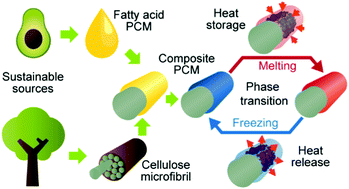Facile synthesis of shape-stable phase-change composites via the adsorption of stearic acid onto cellulose microfibers†
Abstract
Phase change materials (PCMs) offer an exciting way to facilitate energy generation from renewables and develop responsive energy management by storing and releasing thermal energy as latent heat of reversible phase transitions. Organic PCMs are attractive due to their high latent heat storage capacity and reliability. However, they lack shape stability. Here, we propose a simple approach to prepare shape-stable phase-change composite fibers by adsorption of stearic acid onto the surface of cellulose microfibrils. Electron and confocal microscopy demonstrated that the resultant composites were solely cellulose ribbons 10–15 μm across uniformly covered with a stearic acid layer. Fourier-transform infrared spectroscopy confirmed that stearic acid couples with cellulose by physical adsorption without any surface modification of cellulose fibers. Differential scanning calorimetry showed that the composites have an adjustable latent heat storage capacity of 108–125 J g−1 depending on the mass content of stearic acid (60–70 wt%), which was stable during 20 melting/freezing cycles. The leakage test demonstrated that the confinement of stearic acid onto the cellulose microfibrils prevents its leakage during the solid–liquid phase transition at temperatures comparable to the melting point of stearic acid. Finally, the composite fibers were tested as a thermoregulating additive to a commercially available cement mortar mix.



 Please wait while we load your content...
Please wait while we load your content...